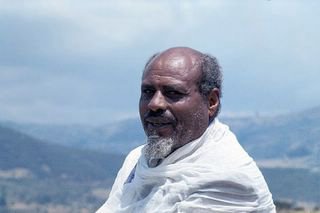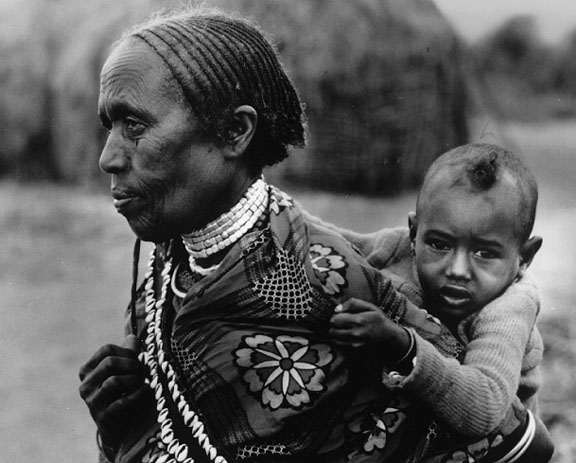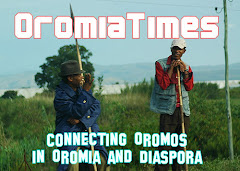
Qaalluu, L. Herbert 1965/66

"All peoples have the right of self-determination. By virtue of that right they freely determine their political status and freely pursue their economic, social and cultural development." Aricle 1 of International Convenant on Civil and Political Rights


7 comments:
The Qaaiiu institution has political importance, even though the Qaaiiu himself does not possess political power as such and religion is distinctly separated from politics. The Qaailu village is the spiritual centre, where political debates are organized for the candidates for the Gadaa offices. Thus he plays both a spiritual and political role in the Gadaa system. For instance, during the fifth year of the Gadaa period, the Gadaa class in power honours the Qaaliu by taking gifts and making their pledges of reverence. This is the Muuda or annointment ceremony. As the head of the council of electors, the Qaaliu organizes and oversees the election of Gadaa leaders.
The Qaallu institution was once a repository of important ceremonial articles (collective symbols) in the Buttaa (Gadaa) ceremony, such as the bokku (sceptre), the national flag, etc. The national flag is made in the colours of the Qaallu turban (surri ruufa). The national flag had three colours - black at the top, red in the centre and white at the bottom. In the Gadaa, the three colours, black, red and white, represented those yet to enter active life, those in active life (Luba) and those who had passed through active live, respectively. The use of these symbols is prohibited by the colonial government.
The Oromo Qaallu must not be confused with the Amhara Qaailicha, who has a very different, much lower, social status. He is a vagabond who resorts to conjuring and black magic for his own benefit, (Knutsson, 1967). He is notorious for extracting remuneration by threats or other means. On the other hand, it is beneath the dignity of an Oromo Qaallu to ask his ritual clients for gifts or payment. The Abyssinian ruling class has confused the terms, thus disparaging the Qaallu socially and religiously by using the term depreciatingly.
The place of worship of Qaaliu ritual house is called the Galma. Each ayyaana has its own Galma and its own special ceremonies. The Galma is usually located on a hill top, hill side or in a grove of large trees. Many of these sites are now taken up by Abyssinian Orthodox Church buildings or Mosques. Places of worship also include under trees, beside large bodies of water, by the side of big mountains, hills, stones, etc. This has been misrepresented by outsiders claiming that the Oromo worship trees, rivers, etc.
The believers visit the Galma for worship once or twice a week, usually on Thursday and Saturday nights. At this time the followers dance, sing and beat drums to perform a ritual called dalaga in order to achieve a state of ecstasy, which often culminates in possession. It is at the height of this that the possessing ayyaana speaks through the Qaallu's mouth and can answer prayers and predict the future.
Religious Oromo often made Muuda-piigrimages to some of the great Qaaiius and religious centres such as Arsi's Abbaa Muuda (father of anointment). Among the Borana Oromo Muuda pilgrimages are still common. Muuda pilgrimage is very holy and the pilgrims walk to the place of Abbaa Muuda with a stick in one hand and carrying myrrh (qumbii). All Oromo through whose village the pilgrims pass are obliged to give them hospitality. As the Mecca pilgrims are called Haj among Muslims, these Muuda pilgrims are ca!ied Jiia.
The Qaalluu institution was weakened with the advent of colonialism to Oromia, which reduced contacts between various Oromo groups. The pilgrimage was prohibited. It became the policy to discourage and destroy Oromo cultural institutions and values. The Qaalluu institution has suffered more during the last 14 years than it suffered during the previous 100 years. At this stage it faces complete eradication and Orthodox Church buildings are fast replacing Gaimas.
Just before the beginning of the harvest season every year, the Oromo have a prayer ceremony (thanksgiving festival) called irreessa. It once took place in river meadows where now the Abyssinian Orthodox Church takes its holy Tabot (tablets) for special yearly festivals, the 'timqat'. The lrreessa has become illegal and anybody who attempts to practise it is now likely to be imprisoned.
Sorce of the above information about Qaalluu is http://www.oromia.org/OromiaBriefs/Oromo&Oromia.htm
Post a Comment